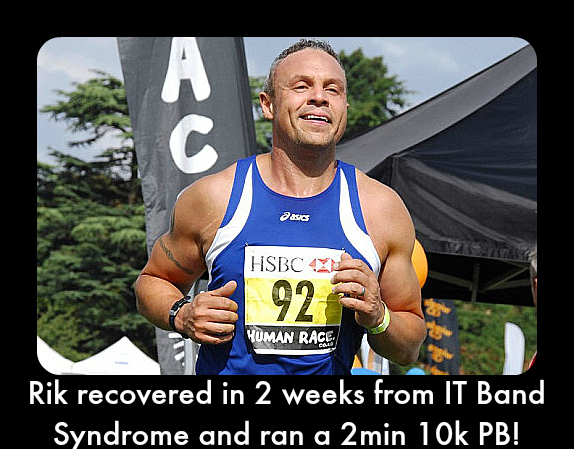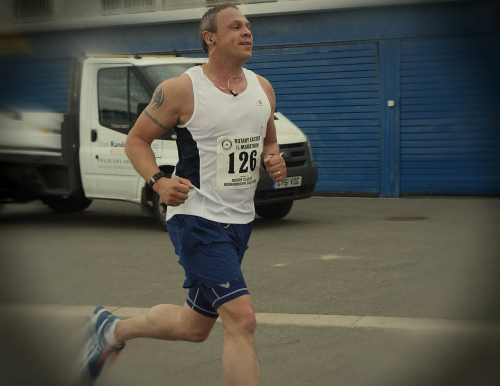Rik is a runner who sets big goals – actually, ENORMOUS goals that most of us wouldn’t ever dream of imagining.

At the age of 40, Rik found that he was overweight and prioritized work over fitness. Like many of us, he realized that registering for a race might help him get back in shape.
But instead of just registering for one race, he went big with a series of goals. Throughout 2014, his goals were to run a lot of different races:
- 5k
- 10k
- Quarter-marathon (6.55 miles)
- Half Marathon
- Marathon
- 100k ultramarathon
- Several duathlons
- A handful of triathlons
C’mon Rik, you’re making us all feel lazy!
This is what I like to call a stretch goal – those “pie in the sky” dreams that boost our motivation, keep us committed, and propel us to new levels of performance. Rik took advantage of stretch goals to get back into shape after finding he was gaining weight.
And it worked.
In December, 2014, Rik had completed all of his race goals – with the exception of the marathon. Three weeks before the race, he suffered an IT Band injury.
But that didn’t stop him – even though rest alone didn’t cure his IT Band Syndrome, he told me that, “I crazily ran the marathon through 26.2 miles of agony.” Ouch.
Then, after seeing two specialists and resting for months, he still wasn’t healthy. His injury persisted, causing excruciating pain when he walked, ran, and rode his bike.
Frustrated, Rik started searching for solutions to his ITBS injury online and came upon Strength Running. He found the Injury Prevention for Runners program and decided to give it a try.
Two weeks later, he was running pain-free.
What can we learn from Rik’s comeback? Why did two doctors (who were knee injury specialists) fail to get him healthy, while an online program (from a coach he’d never met!) helped him get healthy in one-sixth of the time?
Let’s dive into several quotes that Rik shared with me and the lessons that we can learn from them.
I think this will be very illuminating so if you’re someone who constantly suffers through running injuries, pay special attention.
7 Lessons on Dealing with Injury, How to Stay Healthy, and ITBS Recovery
Rik and I had several emails back forth as we talked about his injury, recovery, and experience with the Injury Prevention program. Below are excerpts of what Rik told me and my responses.
I had previously been with a great coach, but strength training was not part of the program – it was for me to do on my own.
Lesson #1: Coaches must provide well-rounded training that includes a lot more than just running. If your coach (or YOU if you coach yourself!) only gives running workouts, you’re missing a huge piece of the puzzle.
This is like a Realtor who only helps you find your dream house, but then doesn’t walk you through the inspection and closing processes. They’re simply not doing everything they need to be doing.
The injury would not disappear no matter how much rest I gave. Every time I thought the pain had disappeared it came back as soon as I walked down a hill or tried to slowly run or cycle. This went on for nearly 3 months.
Lesson #2: Stop treating running injuries with rest! Ignoring the problem does not solve the problem.
The best runners bounce back quickly from injuries because they’re aggressive with their treatment. They start immediately, they stick to the plan, and they get help when needed (a “lone wolf” often stays injured for longer).
I was referred to 2 different knee injury specialist physios, but their plans of massage, ice, friction massage, stretches, ultrasound, and of course rest made no difference.
Lesson #3: Specialists who don’t specialize in runners (or aren’t runners themselves), won’t give the best injury treatment advice.
They’ll often treat the symptoms of the injury but rarely target the root cause of the problem. If it were me, I’d find a new doctor if their only treatments were the standard stuff:
- Rest
- Ice
- Massage
- Ultrasound
These are fantastic prevention measures, but as treatments they’re less than ideal. They may help you feel better, but they likely won’t help you run better.
My running was fine and improving, but did not have any running-specific strength exercises. I found at the end of long runs (15+ miles) my form would be suffering and my knees and hips would be tender.
Lesson #4: Strength work should never be an after-thought. It’s not a “nice to have” – it’s a MUST HAVE for any runner who wants to run a personal best and stay healthy long-term.
Injury prevention needs to be baked into your training. I discuss this in more detail in this video:
The transition from how I used to train to Jason’s philosophy included conscious planning to ensure the activities were carried out regularly, being patient, and being focused. And ensuring I gave the program time to see if it was successful.
Lesson #5: You have to put in the work. If you expect overnight results with half-hearted effort, you’re delusional.
Just the other day I got an email from a runner that complained he wasn’t healthy from his injury three days after he purchased Injury Prevention for Runners. THREE DAYS!
C’mon people, you and I know that the body can’t heal itself from a significant injury that fast. Be patient and results will come.
I learned that injuries can happen to anyone.
Lesson #6: Injuries CAN happen to anyone! The longer you run without prioritizing injury prevention, the more at risk you are for getting hurt.
The approach in the Injury Prevention program is actually designed for healthy runners so that you can stay healthy long-term, prevent significant injuries, and run more consistently.
As a results-oriented coach, this is what I care about most. And it shows: my runners get faster and stay healthier than most other runners.
This makes me brag about my runners constantly to my wife (bless her heart), but more importantly, it helps runners like you enjoy their training and accomplish more of their goals.
I bought the Injury Prevention program after reading reviews of people who had successfully recovered.
Lesson #7: Don’t take my word for the success of the program. I’m biased, after all.
Read the case studies.
Check out the growing number of testimonials.
And listen to Rik:
My advice is to take control and proactively tackle your injury using Jason’s proven and simple-to-follow program. Rest is often not enough, and without correcting the underlying issues injuries may well reoccur.
Take control. Be proactive. Correct the underlying issues.
That’s the best injury treatment advice I’ve heard in a long time.
How is Rik Running Now?

Rik thrived on the Injury Prevention for Runners program. He told me:
I found the simplicity, the routine, the explanations in clear and concise English very helpful. And the fact that the program makes me conscientiously proactive in my training to ensure things don’t go wrong again.
He was able to recover quickly – only two weeks! – from a potentially serious injury. If you remember my own battle with ITBS, I was injured for six months!
But more than that, Rik stayed healthy long after he recovered. Just this week, he emailed me with this:
After starting the program, my recovery improved significantly – the next day my body was feeling a lot stronger and less stiff; my ability to tackle hills (something I used to hate) has really improved and the strength helps with my form uphill. This has really improved my all-around training.
I also completed a duathlon in good time, a half marathon trail race, and actually beat my 10k personal best by almost 2 minutes last week which was a real surprise!
Rik also finally understood WHY his IT band injury occurred in the first place. In the program, I discuss the key contributors to and myths about each injury, and explain why we’re doing the treatments.
Finally, Rik has one last thought to share:
Prevention is much better than cure (simple activities would have prevented my 3 month injury zone, plus probably 3-4 months to get back to previous levels).
The old adage is true: an ounce of prevention is worth a pound of cure.
If you’d like to stay healthy long-term and realize your running potential, learn more about Injury Prevention for Runners here.
Already injured? No worries. There’s step-by-step treatment programs for Plantar Fasciitis, Runner’s Knee (PFPS), ITBS, and Achilles Tendinopathy.
Run strong and stay healthy!